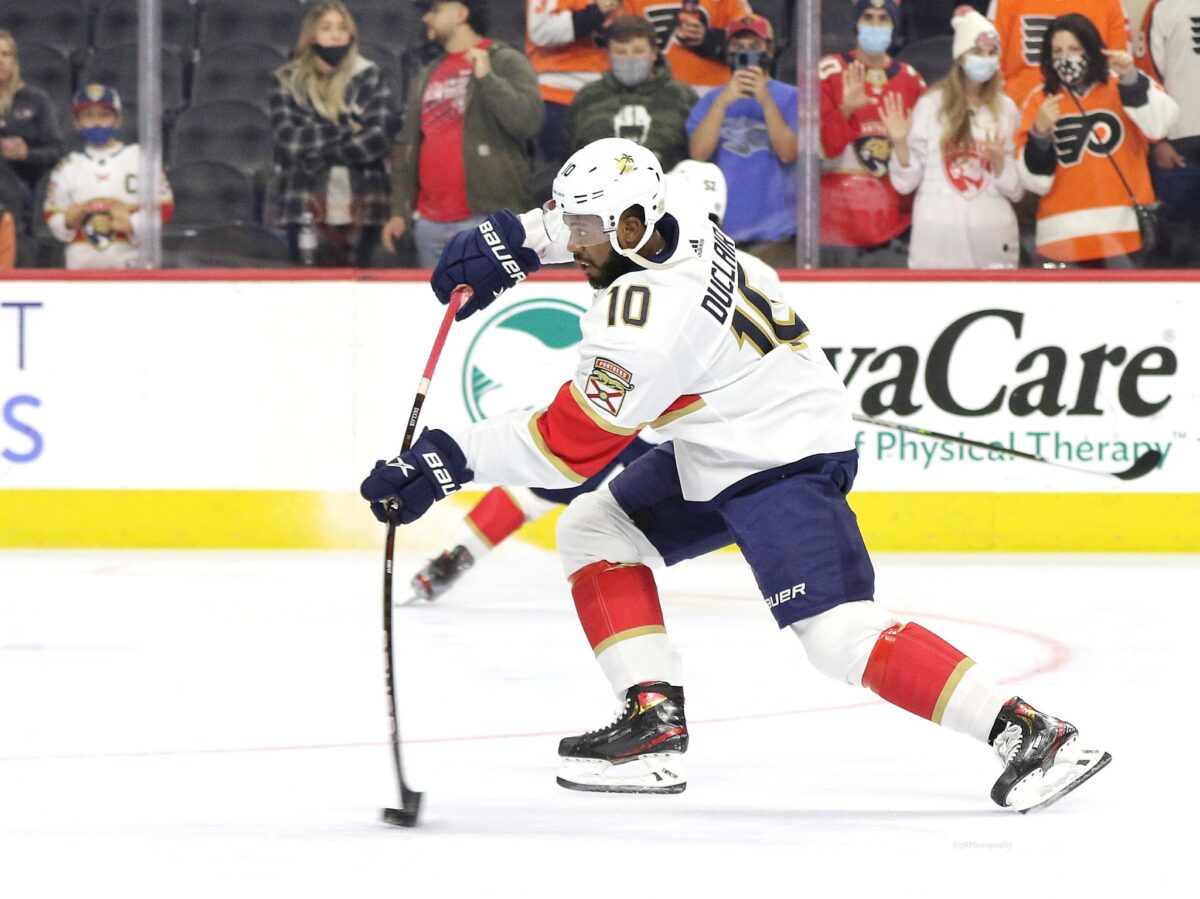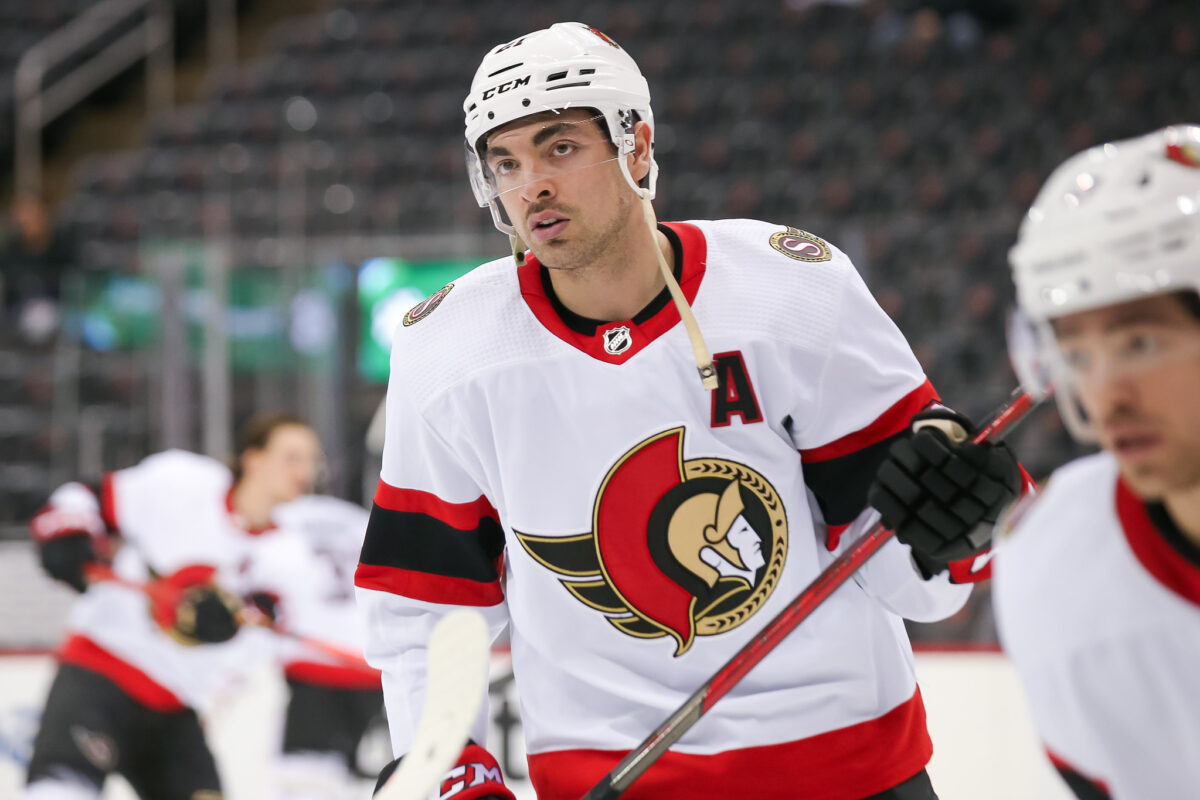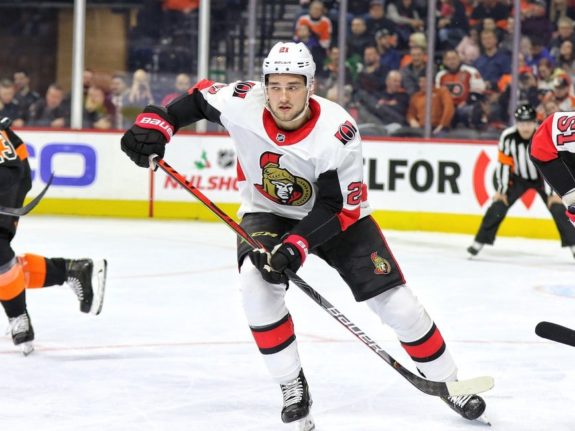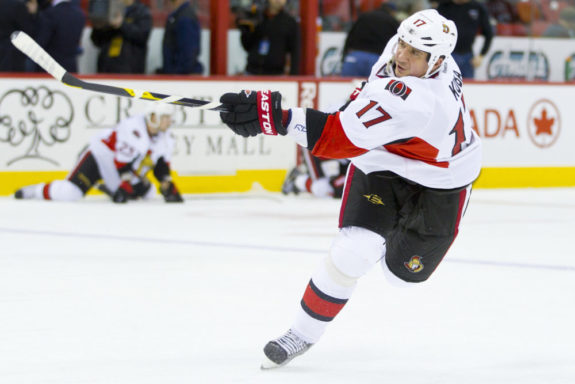Numbers are a fascinating aspect of professional sports. They were first brought in as an attempt to identify who was doing what, and thus more accurate statistics could be kept. At first, certain numbers were attributed to certain positions and a player’s place on the depth chart, with higher numbers denoting lower importance, but as more teams were added to the NHL, the need grew for more numbers which allowed some to add more of a personal touch to what they wore on the back of their uniforms. Wayne Gretzky chose to wear 99 after his first choice, 9 – the number of his hero, Gordie Howe – was already taken, and he lucked his way into doubling the number in the minors. Mario Lemieux then chose 66 as a reference to Gretzky, flipping the iconic number upside down, as a reference that he believed he could be better than him.
Other numbers aren’t as important to players. Daniel Alfredsson’s No. 11 is iconic for the Ottawa Senators and was recognized as such with it being retired in 2016 after he spent 13 years with the team and set records for goals, assists, and points. But he had little say in the matter of choosing it; he was given 63 in training camp, and when he made the team, he was given the choice of either 11 or 22. He seemed to remember wearing 11 in soccer as a child, so that’s what he went with.

Many players who have gone through the organization share a similar story with Alfredsson in that their number was offered to them because it was available. But few have had the same impact as the 2022 Hall of Fame inductee. When someone’s time finishes in Ottawa, their number is simply passed to the next player, creating a long list of players to share one number. Those shared sweaters create mini time capsules, offering a glimpse into the history of the franchise, featuring hopeful prospects, short-term stars, and brief visits from veterans. With all that said, here are the seven most- worn jersey numbers for the Senators.
No. 2 – 15 Players
Currently, when Senators fans see the No. 2, they are most likely to think of its current owner, Artem Zub. Since arriving in 2020-21, he’s been a revelation for Ottawa’s defence, providing much-needed defensive support while chipping in regularly on offence. In his first season, he finished with 14 points in 47 games but more notably had a plus-4. Only Nick Paul played more games and had a higher rating, finishing the season with a plus-five. Zub took a step forward in his offensive game, scoring 22 points last season while playing 81 games, and if he continues this trajectory, he’ll become the most famous ‘2’ the team has ever seen.

Zub may already be there, too, as competition for the top spot is pretty thin. Dion Phaneuf likely holds it right now after putting up two 20-plus point seasons in 2015-16 and 2016-17. However, most other franchises around the league wouldn’t recognize him with a No. 2, as he only ever wore it while playing in Ottawa. When he was acquired in the nine-player trade with the Toronto Maple Leafs, defenceman Marc Methot was already wearing No. 3, and so he went with No. 2, which recently became available after Jared Cowen was sent the other way in the aforementioned deal.
However, Brian Pothier has the most points while wearing the number, scoring five goals and 30 assists in 2005-06, his last season with the team. It is interesting to note that no player has worn the No. 2 for longer than four seasons, with stay-at-home defenceman Lance Pitlick holding the record. The first player to wear the number was Jim Kyte, an Ottawa native and the first deaf player to play in the NHL, who signed with the team in 1992-93. He was one of the NHL’s premier tough guys with the Winnipeg Jets in the 1980s but only ever played four games for his hometown team, spending most of the season in the minors recovering from ankle surgery.
Senators to wear No. 2: Jim Kyte (1992-93), Radek Hamr (1992-93), Kevin MacDonald (1993-94), Jim Paek (1994-95), Lance Pitlick (1995-1999), Bobby Dollas (1999-00), Grant Ledyard (1999-00), Curtis Leschyshyn (2000-01), Brian Pothier (2002-06), Lawrence Nycholat (2006-07), Luke Richardson (2007-09), Jared Cowen (2011-16), Dion Phaneuf (2015-18), Dylan DeMelo (2018-20), Artem Zub (2020-present)
No. 10 – 15 Players
Andreas Dackell was an underrated hero during his five seasons with the Senators, and to this day, no one has surpassed him while wearing the No. 10. He was the first player in franchise history to score in his debut on his very first shot (followed by Wade Redden less than 20 minutes later) and became an excellent special teams player, putting up a career-high 50 points in 1998-99. Unfortunately, he was largely overshadowed by Alfredsson, Alexei Yashin, and Marian Hossa during his time with the team. He was traded to the Montreal Canadiens ahead of the 2001-02 season for a measly seventh-round pick.
Peter Bondra could have been a great pick-up for the Senators, as he already was one of the biggest stars of the 1990s after spending 14 seasons with the Washington Capitals and putting up three 80-plus point seasons. However, he didn’t join the Senators on the best of terms in 2003-04, as he was heartbroken to leave his beloved Capitals. However, at 36 years old, he was one of the few players who could bring in a decent return to the rebuilding team. Making matters worse Bondra’s No. 12, which he wore all his career, was being worn by Senators veteran Mike Fisher. Rather than ask him for it, he settled for No. 10 and went on to score 14 points in 23 games, but then went scoreless in seven playoff games with the team.
You may also like:
- Ottawa Senators Prospect of the Week – Blake Montgomery
- Revisiting the Blackhawks’ Alex DeBrincat Trade
- NHL Rumors: Rangers, Maple Leafs, Senators, Canadiens
- Oilers Snap Senators’ 6-Game Winning Streak, Win 3-1
- Projected Lineups for the Oilers vs Senators – 12/22/24
Anthony Duclair was another unfortunate situation, as he instantly clicked with the Senators when he arrived after the 2019 Trade Deadline. Ottawa was in a tailspin and looking for anything that could give them a boost, so they shipped out 20-goal scorer Ryan Dzingel to the Columbus Blue Jackets for two picks and Duclair. In the final 21 games of the season, he was on fire, scoring eight goals and 14 points, then put up 40 points in 2019-20, the fourth-highest total on the team. With an expiring contract on the horizon, he was eager to earn a big payday, but the Senators balked at the proposition, leaving him unqualified, after which he signed with the Panthers, where he’s been a star ever since.

Alex Formenton currently wears the No. 10 for the Senators and has done well over the past two seasons with the team. His best season came just last year when he scored 32 points in 78 games. However, he too is looking for a new contract and although he was qualified, no new deal has been reached yet.
Senators who wore No. 10: Darcy Loewen (1992-94), Rob Gaudreau (1994-96), Andreas Dackell (1996-01), Toni Dahlman (2001-03), Peter Bondra (2003-04), Brandon Bochenski (2005-06), Tyler Arnason (2005-06), Shean Donovan (2007-10), Marek Svatos (2010-11), Mike Lundin (2012-13), Shane Prince (2014-16), Tom Pyatt (2016-19), Anthony Duclair (2018-20), Ryan Dzingel (2020-21), Alex Formenton (2021-present)
No. 23 – 15 Players
As of right now, Travis Hamonic may be the most recognizable player to wear No. 23, for better or worse. He was acquired in a deal with the Vancouver Canucks at the 2022 Trade Deadline that saw the Senators part with a third-round pick. While that price is far from unreasonable for a right-handed defenceman who has hit the 20-point mark three times in his career, it’s less so when considering he was on waivers earlier that season and went unclaimed. However, despite the controversy surrounding his arrival, he looked pretty good when he stepped on the ice, providing solid veteran support for a defence corps that was filled with holes.

Hamonic’s career with the Senators spans just 19 games, though, so the jury is still out on crowning him in the top 23. Instead, that belongs to fellow right-handed defender Karel Rachunek. Ottawa’s ninth-round pick in 1997, he made his NHL debut in 1999-00 with the No. 44 but came back the following season with No. 23. With an increased role, he finished second among the team’s defensemen in scoring with 33 points and he even got some outside consideration for the Calder Trophy, receiving two fifth-place votes. Injuries limited him to just 51 games in 2001-02 and a contract dispute forced him to miss the beginning of 2002-03. But when he returned, he put up an impressive 29 points in 58 games, a career-high pace of 0.5 points-per-game, adding another four points in 17 playoff games.
Unfortunately, Rachunek began to slide after his return and was dealt to the New York Rangers the following season for veteran Greg de Vries, pushing No. 23 into the closet until a little-known Latvian emerged onto the scene. Kaspars Daugavins was a talented goal-scorer in the minors, prompting the Senators to use a sixth-round pick on him in 2006 and finally bringing him aboard in 2009-10 for his first NHL game. However, that was the only one he’d play until 2011-12, when he was brought up as a regular, playing in 65 games and scoring 11 points from the bottom of the roster. But fans don’t remember his tenacity or defensive abilities. They remember his unbelievable shootout attempt in 2012-13.
Despite the play not resulting in a goal, it was unbelievable that someone would try that in an actual game. That action alone cemented Daugavins in Senators’ history, and when he was waived just two weeks later, fans were upset, even though they likely had no idea who he was before that season. The Boston Bruins took him off Ottawa’s hands, but he lasted just six games there, plus six playoff games, before returning to Europe, where he continues to fill the net.
Senators who wore No. 23: Chris Luongo (1992-93), Brian Glynn (1993-94), Claude Boivin (1994-95), Jaroslav Modry (1995-96), Christer Olsson (1996-97), Radim Bicanek (1997-99), Yves Sarault (1999-00), Karel Rachunek (2000-04), Kaspers Daugavins (2009-13), Scott Gomez (2015-16), Jyrki Jokipakka (2016-17), Nick Shore (2017-18), Cedric Paquette (2020-21), Andrew Agozzino (2021-22), Travis Hamonic (2021-present)
No. 28 – 16 Players
Only two players have worn No. 28 for longer than two seasons. The first was Todd White, who signed with the Senators in 2000-01. Although a college standout, he went undrafted and signed as a free agent with the Chicago Blackhawks but failed to make much of an impact in the Windy City and was traded to the Philadelphia Flyers in 1999-00. He also didn’t do much there, spending most of his time in the minors, before signing with Ottawa. Maybe it was the joy of playing for his hometown team, or maybe everything just clicked. Whatever it was, it helped him score 50 points in his first full season with the team only to top it with 60 points the season after. After a less than impressive 2003-04 season, he was not re-signed when the NHL re-convened after the lockout.
Related: They Wore It Once: Senators Players and Their Unique Numbers
The second long-term No. 28 came 15 years later with Connor Brown, who was acquired in a six-player deal with the Maple Leafs ahead of 2019-20. Like White, he instantly clicked with the team, scoring 43 points in his first season and 21 goals and 35 points in 56 games during the pandemic-shortened 2020-21 season. However, with the rest of the team improving around him, he began to slip down the roster and became a scapegoat during the frustrating 2021-22 campaign. With the team making big changes ahead of the 2022-23 season, he was deemed replaceable and traded to the Washington Capitals for a draft pick, leaving No. 28 unowned once again.

Several stars of the 1990s passed through Ottawa and donned No. 28. Steve Duchesne was the team’s top defencemen for two seasons, although he never got close to his 82-point career high he recorded with the Quebec Nordiques in 1992-93. Joe Juneau, who set the record for the most assists for a left-wing in 1992-93 when he dished out 70 helpers for the Boston Bruins, made a brief pitstop with the Senators in 1999-00. Grinders Stephen Leach, Ted Donato, and Martin Lapointe also stepped in for a few games as their careers were winding down.
Senators who wore No. 28: Jeff Lazaro (1992-93), Mark Osiecki (1992-93), Bill Huard (1993-95), Steve Duchesne (1995-97), Denny Lambert (1997-98), Ted Donato (1998-99), Stephen Leach (1998-99), Joe Juneau (1999-00), Todd White (2000-04), Martin Lapointe (2007-08), Zenon Konopka (2011-12), Matt Kassian (2012-14), Cody Goloubef (2018-20), Paul Carey (2018-19), Connor Brown (2019-22).
No. 21 – 16 Players
Before 2002-03, the only player who had worn No. 21 longer than a season or two was Dennis Vial, who played from 1993-1998, during which he scored 17 points and spent 625 minutes in the penalty box, many of which for fighting. But a trade with the Kings changed that, with the Senators sending 20-year-old Tim Gleason to the West Coast for aging center Bryan Smolinski. He ended up being exactly what the team needed at the time, filling a crucial role as a reliable veteran scorer. He scored eight points in his first 10 games in Ottawa, was fourth on the team in scoring in the 2003 Playoffs, then finished fifth in regular season scoring in 2003-04 with 19 goals and 46 points. He was even better in 2005-06, scoring 48 points, but left the team in free agency, signing with the Chicago Blackhawks for the 2006-07 season.
It took nearly 14 years before another player filled Smolinski’s shoes as a reliable, all-around player for the Senators. Nick Paul was acquired in the trade that sent Jason Spezza to the Dallas Stars and was seen as a promising prospect, but a bit of a longshot. He was given No. 13 when he first joined the team after wearing the number in the American Hockey League (AHL), and for five seasons, he stuck with it while trying to establish himself in the professional ranks. Finally, in 2019-20, it all came together for him, as he put up 20 points in 56 games with the Senators. With an ever-growing reputation as a hard worker and defensive specialist, he took advantage of Derek Stepan’s departure in 2020-21 and grabbed No. 21 from him and went on to post another 20-point season.

Paul was on pace to beat it in 2021-22 before he was traded to the Tampa Bay Lightning for Mathieu Joseph, who took the No. 21 from him, one he wore while playing with the Quebec Major Junior Hockey League’s (QMJHL) Saint John Sea Dogs but hadn’t been able to get it while with Tampa Bay because it belonged to star Brayden Point. But in Ottawa, it was fair game, and he looked immediately comfortable with it on. In 11 games, he scored 12 points, which earned him a four-year extension worth nearly $3 million a season. It’s fair to say that if he can keep that up, he’ll easily become the best No. 21 in Senators history.
Senators to wear No. 21: Dominic Lavoie (1992-93), Martin St. Amour (1992-93), Dennis Vial (1993-1998), Andreas Johansson (1998-99), Kevin Miller (1999-00), David Oliver (2000-01), Steve Martins (2001-03), Bryan Smolinski (2002-06), Jason Smith (2008-09), Ryan Potulny (2010-11), Nikita Filatov (2011-12), Mike Kostka (2015-16), Logan Brown (2017-20), Derek Stepan (2020-21), Nick Paul (2020-22), Mathieu Joseph (2021-present)
No. 27 – 16 Players
The No. 27 seems to be a bit of a tale of missed opportunities for the Senators. Of the 16 players who have worn it, many were young players who couldn’t find their game in Ottawa. However, none of them compare to the disappointment experienced with Logan Brown. Taken 11th overall in 2016, the 6-foot-6 forward promised to be a key piece in the Senators’ rebuild. However, in his brief call-ups in 2017-18 and 2018-19, he looked overwhelmed by the pace of the NHL game, so he was returned time and again to the minors, where he continued to excel. He finally stuck around for an extended time in 2019-20, playing 23 games before an injury derailed his season.

The injury issues carried over in 2020-21, and so Brown tried something different, switching over from No. 21 to No. 27, seemingly hoping to kick start his season and career in Ottawa. Yet he was still limited to just 13 AHL games and one NHL game. Finally, the Senators decided enough was enough and they shipped their once-promising prospect to the St. Louis Blues for Zach Sanford.
But not everyone had bad luck with 27. Peter Schaefer switched to the number in 2005-06 after two seasons of wearing 15 and followed up the change with his two most productive years in his NHL career, scoring 50 and 46 points in subsequent seasons. With his value at its peak, the Senators sent him to the Bruins for Shean Donovan, who became a fan favourite but never had the offensive impact of Schaefer.
Senators who wore No. 27: Blair Atcheynum (1992-93), Phil Bourque (1993-94), Hank Lammens (1993-94), Joe Cirella (1995-96), Janne Laukkanen (1995-00), Ricard Persson (2000-02), Dennis Bonvie (2002-03), Todd Simpson (2003-04), Peter Schaefer (2005-07), Randy Robitaille (2007-08), Alex Kovalev (2009-11), Curtis Lazar (2014-17), Johnny Oduya (2017-18), Jordan Szwarz (2019-20), Logan Brown (2020-21), Dylan Gambrell (2021-present)
No. 17 – 18 Players
The first player to wear the No. 17 in Ottawa was Jody Hull, who was traded to the team shortly before the 1992-93 season by the New York Rangers. The number he wore the season prior, 21, had already been claimed by Dominic Lavoie, who had been selected in the 1992 Expansion Draft a couple of weeks before, so he grabbed No. 17. With his new number, he tied his career best of 34 points, but the team only won 10 games that first season, so he decided to try something else, signing with the Panthers for 1993-94.
After Hull, the number was passed around to several players who only stuck around for a season or two, including Dave McLlwain, Tom Chorske, and Bill Muckalt, who was famously acquired in the trade that brought both Zdeno Chara and Jason Spezza to Ottawa. But no one made the number popular until Filip Kuba, who signed with the team before the 2008-09 season. Already a decent offensive defenceman, he took his game to a new level in his first year with the team, scoring 37 assists and 40 points, both career bests, and finished fourth on the team in points.

Kuba remained with the team for four seasons, wearing No. 17 the whole time, the longest stretch a player has worn the number with the team. Although he never recaptured that initial magic, he was a valuable part of the defence corps. When he left the Senators after the 2011-12 season, the number fell into disuse until David Legwand joined the team in 2014-15. The long-time Nashville Predator sported No. 11 until getting traded to the Detroit Red Wings in 2013-14, where Alfredsson, of all people, was already wearing the number, so Legwand took No. 17 and kept it until he retired in 2015-16.
Max McCormick wore it while with Ohio State University and the Binghampton Senators, but when he joined the Senators in 2015-16, he was given No. 89, as many young players are given high numbers when they first arrive in the NHL. He finally was given his junior number in 2018-19, but after 14 NHL games, he was shipped off to the Colorado Avalanche for J.C Beaudin and hasn’t been able to get it back since. Adam Gaudette was the last player to don 17 in Ottawa, wearing it for 50 games in 2021-22, but with his departure to the Toronto Maple Leafs, the number was going to fall into disuse again until Ridley Greig wore it for the 2022-23 season.

Senators who wore No. 17: Jody Hull (1992-93), Dave McLlwain (1993-1995), Tom Chorske (1995-97), Chris Murray (1997-99), Colin Forbes (1999-2001), Eric Lacroix (2000-01), Bill Muckalt (2001-02), Filip Novak (2005-06), Denis Hamel (2006-07), Filip Kuba (2008-2012), David Legwand (2014-15), Nate Thompson (2017-18), Brian Gibbons (2018-19), Max McCormick (2018-19), Jonathan Davidsson (2019-20), Alex Galchenyuk (2020-21), Adam Gaudette (2021-22)
Youngsters Have a Chance to Make Senators History
So far, none of these numbers are tied to a player who will ascend to the level of Phillips or Alfredsson, but there may be some rookies coming up that could make their mark on the franchise. After a dominant performance at the 2022 World Juniors, Ridly Greig looks like a future stud. It’s not surprising to those who have watched him with the Brandon Wheat Kings, though, where he’s been one of the Western Hockey League’s most fearsome power forwards, all while wearing No. 17. His Team Canada linemate, Zach Ostapchuk, also had a strong tournament and has worn No. 10 with the Vancouver Giants during his four seasons there. Maxence Guenette has kept his No. 21 in the AHL after donning it with the Val-d’Or Foreurs and could make his NHL debut in 2022-23, but Roby Jarventie may get there first and beat him to it.
No matter what number a player ends up wearing, however, fans are always hopeful that the newest players will become worthy of having their jersey hung from the arena’s rafters after a long and fruitful career with the team. While it’s impossible to say what the future will hold, it’s too tempting to wonder who the next great number will be in Ottawa.
